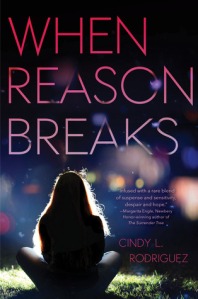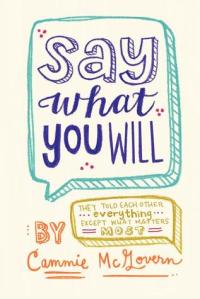Hie thee over to www.disabilityinkidlit.com for a brand-new site!
L. Lee Butler reviews WHEN REASON BREAKS
 L. Lee Butler is a middle school librarian in the DC Public Schools. He’s a pretty typical librarian : likes to read, does crafts, gay. In addition to serving on YALSA’s Best Fiction for Young Adults Selection Committee 2013, he also reviews diverse titles for School Library Journal.
L. Lee Butler is a middle school librarian in the DC Public Schools. He’s a pretty typical librarian : likes to read, does crafts, gay. In addition to serving on YALSA’s Best Fiction for Young Adults Selection Committee 2013, he also reviews diverse titles for School Library Journal.
The hook of When Reason Breaks, as presented in the flap copy, is to present two very different girls and tease the reader as to who will attempt suicide. Although that seems crass, showing the parallel journeys of Emily and Elizabeth allows author Cindy L. Rodriguez to explore two different expressions of depression. That either one of them could believably be the girl overdosing at the opening of the book all the way up to the ultimate reveal is the result of the author’s deep understanding of the manifold ways that depression affects people, as well as skillful misdirection.
Elizabeth Davis and Emily Delgado are classmates without much socially between them despite their last names leading them to be seated next to each other in every class. Emily is fresh off a social media debacle that led her politician father to punish her in humiliating ways. Elizabeth has rage and angst fueling her gothy new persona. And both of them will be studying Emily Dickinson in Ms. Diaz’s English class. The novel takes much of its structure and characterization from Dickinson’s poetry, biography, and speculation about her life, but keeps its influences from overwhelming the narrative.
Elizabeth’s depression is the more stereotypical teen girl depression depicted in many novels, with goth fashion decisions, secretive poetry, and violent acting out. Her depression is revealed piecemeal, so it’s not until much later in the book that we see its particular genesis. It is a testament to Rodriguez’s skill as a writer that these often-used character traits do not feel stale, but are part of a character that feels very real. It’s no wonder that Ms. Diaz latches onto her issues before Emily’s, and it is a welcome choice to see a teacher in a YA novel taking appropriate measures to deal with an obviously troubled student. I know I am not the first well-meaning adult reader of YA literature to be (inappropriately) frustrated with the lack of adult presence in the genre, so I am glad to see the depiction of a well-boundaried adult who is there for her students struggling with mental health issues. But Ms. Diaz is not the adult-insert savior of Elizabeth or Emily; she is a realistic but completely inadequate resource just like those I encountered as a depressed teenager.
But the depiction of Emily’s depression is the real jewel in the novel, painfully accurate to the kind of feelings and actions that are less showy than the typical treatment of depression in media. Without a traumatic root, Emily’s depression is an organic thing that dictates her reactions to the normal ups and downs of teenage life, which is a rarity for narrative depictions of depression. Her position as a pretty, popular girl does not save her from her mental illness. As her downward spiral begins, we get a telling glimpse into the way that depressive mindsets not only make everyday struggles difficult, but add guilt on to the struggle.
Emily looked at Mama and Pop and thought about her friends and Kevin. Like Jacob, they all had struggles, but none of them had faced a major tragedy. She watched the news. Compared to others, her life and her problems were pretty ordinary. So why did it all feel like she was in an epic battle? Why did every snarky remark become a festering wound? Why did she always feel like she was pinned to the mat and crushed under their weight? (pages 112-113)
Rather than accepting that every life has struggles, the depressive mind tries to put feelings into false perspective. The internal monologue of “your problems aren’t so bad, cheer up!” can feel like it’s coming from a place of balance, but it’s actually just another facet of depression reflecting back on itself. It’s just as destructive as the more obviously self-hating narratives.
I am particularly grateful for and impressed by the unflinching nature of Chapter 35’s depiction of suicide. The mechanical descriptions of CPR and the ministrations of the paramedics are real and unsentimental. The following chapters, showing the fallout for others and the resistance to treatment, are correct to my recollections of a similar time in my life and what has been related to me by my family and friends. Although it is the climax of the novel, the suicide does not stand as the endpoint of the narrative. It is a turning point, as in real life, when rock bottom or a nearby shock can be a catalyst for change. The narrative shift from the past tense to the present underlines the uncertainty that this change brings.
There is so much to recommend When Reason Breaks that it’s impossible to fit it into this review. From the recognition of the physical symptoms of depression to the way diversity is woven into the characters to the realistic role that social media plays in the lives of our protagonists, this novel is a real accomplishment of characterization. Depression and suicide is not all there is to Emily or Elizabeth, nor is it the only point of the narrative, but they take center stage in an astutely observed way that is wonderful to read.
Mindy Rhiger reviews CENTAUR RISING
 Mindy Rhiger is a librarian specializing in children’s books. She was born with one arm and has worn a prosthesis since she was a toddler. You can read all about it on her FAQ called Fake Arm 101. Mindy shared more books about being different in an article in Book Links called Just Like You: Helping Young People Understand Disabilities Through Books. She will be serving as a judge on the inaugural Walter Award, which will honor diverse teen fiction in 2015.
Mindy Rhiger is a librarian specializing in children’s books. She was born with one arm and has worn a prosthesis since she was a toddler. You can read all about it on her FAQ called Fake Arm 101. Mindy shared more books about being different in an article in Book Links called Just Like You: Helping Young People Understand Disabilities Through Books. She will be serving as a judge on the inaugural Walter Award, which will honor diverse teen fiction in 2015.
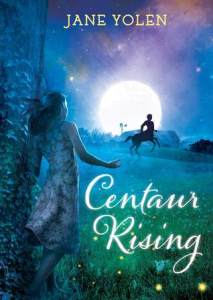 When a review copy of Centaur Rising by Jane Yolen landed on my desk, I immediately put in my “to read” pile. Not because I have any particular interest in centaurs. Nor for the name recognition of the author, though I have enjoyed many of Jane Yolen’s previous books. My initial attraction to the book was based on the reference to “birth defects caused by an experimental drug” in the book description on the back cover. How many middle grade novels reference Thalidomide? Centaur Rising is the only one I know of.
When a review copy of Centaur Rising by Jane Yolen landed on my desk, I immediately put in my “to read” pile. Not because I have any particular interest in centaurs. Nor for the name recognition of the author, though I have enjoyed many of Jane Yolen’s previous books. My initial attraction to the book was based on the reference to “birth defects caused by an experimental drug” in the book description on the back cover. How many middle grade novels reference Thalidomide? Centaur Rising is the only one I know of.
Thalidomide, as explained in an author’s note, was an anti-nausea medication taken by pregnant women in the late 1950’s and early 1960’s. It was eventually banned when doctors learned it caused birth defects in children. Most middle grade readers aren’t going to know about Thalidomide. It was well before their time, as it was before my time as well. Nonetheless, I knew about it in the late 1980’s when I was a kid because people of a certain generation saw my limb deficiency and immediately connected it to Thalidomide. I regularly had to tell people that I was not a “Thalidomide Baby,” that my congenital limb difference was random. It remains one of many assumptions people often make about me, and I still find myself having to explain that I am not old enough to have been affected by Thalidomide. There is also the fact that it was never approved for use in the United States, and the affected children (adults now) are largely European or Canadian.
In Centaur Rising, Robbie has the typical “Thalidomide Baby” traits. He is described by his sister Ari as she notes how he wouldn’t be able to help if she needed anything when tending to a horse in labor on their farm: “He can’t use his legs, his pelvic bones are missing, his arms are too short, and his hands are like flippers because the fingers and thumbs grew fused together.”
When the foal turns out to be a centaur, the characters have various reactions. The adults are concerned about what people will think. Ari wonders if the creature is magic or a mistake. Robbie connects with the baby centaur immediately. He says that they are both “half something.” Half human, half animal. It sounds harsh, and I suppose it is harsh to read that a child views himself as only part human. But it is true that kids affected by Thalidomide were called “seal children.”
It is worth noting here that a version of Centaur Rising was originally published in the short story collection Half Human. In the story, the character with the birth defects died at birth, and the family names the centaur after that lost child. In the book version, the child and the centaur consider each other brothers. They both feel freakish and need protection from those who would hurt them or exploit them. Robbie’s father represents all villains here as he treats Robbie harshly and wants to cash in on the centaur’s potential as a moneymaker.
The idea that Robbie relates in any way to the centaur isn’t exactly a comfortable idea for Robbie’s family, but by the end of the book everyone in the family has learned something or shifted perspective thanks to Robbie and his relationship with the centaur. This element of the plot came across as didactic to me, and I didn’t think that either Robbie or Kai were fully fleshed out characters, which made the ending in which they begin a charitable organization for kids with disabilities feel somewhat inauthentic.
In the end, Ari learns that the creature was not a mistake at all. He was magical. He transforms her world and perspective in many ways, and by extension, her brother with all of his differences has an inspirational element to his character. I couldn’t help but wish that there was an option other than magic or mistake offered for Robbie and Kai. Perhaps, like me, they might just be different for no reason and with no obligation.
Despite the elements that I saw as didactic or inauthentic, there is a lot that kids will like in this book. Ari is a relatable character, and her story is satisfying. Readers who are drawn to horse novels or realistic fantasies are the most likely to appreciate this gentle, uplifting story. The author’s note offers more information about Thalidomide, horse therapy, and historical language for people with disabilities for those who are interested in further context. Centaur Rising presents opportunity for teachers or other educators to bring up a discussion of preconceived ideas about people who are different as well as give some historical context to the way that our treatment of people with disabilities has changed. There is a lot to talk about in this story, and if the book can start those, often uncomfortable, conversations about how we view people (or creatures) that look different and how they are represented in fiction, I count that as a good thing.
Alex Townsend reviews ALL THE BRIGHT PLACES
 Alex likes to read and think about things. Like wombats. Did you know wombats have upside-down pouches? It’s to keep dirt off their babies while they dig underground. Keep reading, kids. It’s how you learn things!
Alex likes to read and think about things. Like wombats. Did you know wombats have upside-down pouches? It’s to keep dirt off their babies while they dig underground. Keep reading, kids. It’s how you learn things!
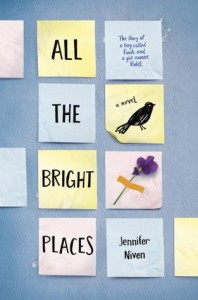 I went into All the Bright Places by Jennifer Niven with my guard up. No matter how good or bad the book was, I knew a story about depression was likely to trigger my own. No surprise, it did. All the Bright Places is a beautifully written book that is, at times, very difficult to read. I’d like to warn the reader up front that this review will have some pretty big spoilers.
I went into All the Bright Places by Jennifer Niven with my guard up. No matter how good or bad the book was, I knew a story about depression was likely to trigger my own. No surprise, it did. All the Bright Places is a beautifully written book that is, at times, very difficult to read. I’d like to warn the reader up front that this review will have some pretty big spoilers.
All the Bright Places is about two teens with depression. Violet’s sister died in a car accident the previous year and Violet blames herself for it. Finch has a long history of acting out and having sudden extreme mood swings. It is heavily implied that he is also bi-polar. At the start of the book both teens have suicidal thoughts, but Finch manages to talk Violet off of a ledge and Violet becomes Finch’s new reason for living. From there the story becomes about their budding romance as well as their personal growth. They learn about themselves and each other while exploring the hidden wonders of Indiana.
Violet and Finch are both very well-written and developed characters. It’s interesting to see them evolve and to understand more of their personal histories. It’s poignant, slice-of-life stuff and the John Green comparisons are sure to pop up. As a representation of how it feels to be depressed, All the Bright Places does a great job. I connected with the way Finch needed to find an active reason to stay alive, how he regularly pushed himself to physical exertion to feel life pumping through him, but still couldn’t stop himself from thinking about all the ways people have killed themselves. It’s a great illustration of the contradictions that can fill a person with depression.
However, now we come to the book’s greatest flaw: this is not a book for people with depression. I would absolutely not recommend it for anyone with depression who was looking for representation. The problem, and this is the big spoiler I mentioned, is that one of the protagonists kills himself. I was worried about this for the entire book. I kept flipping ahead and peaking at the last page, knowing what I saw and hoping I was wrong.
Of the two, Finch is the character with the more deep-rooted mental issues. It’s made clear through the book that he’s had suicidal thoughts for years, which hasn’t been made easier by years of bullying in school, an absent mother, and an abusive father. Being with Violet makes things better for a time, but as the book progresses I could see his dark thoughts coming back. In the end, he runs away from home and isn’t heard from for weeks. Finally Violet finds him, drowned in a lake where they’d had a date.
Suicide is a delicate topic to put in any story. Sometimes it’s used for sensationalism and sometimes it’s meant to illustrate poignant tragedy. In a book about depression though, it’s simply an essential element to discuss. Sadly, depression and suicide go together all too often in the real world. Unfortunately, Finch’s suicide is one that is handled poorly, ruining much of the book.
Once Finch dies, I feel that All the Bright Places really shows its true colors. I have seen this novel advertised as a story about teenage depression, but I don’t think that’s quite right. It’s a book for people with friends who commit suicide. The author admits at the end that it was an experience she went through herself and the last chunk of the story is all about Violet coping with losing Finch.
In his absence Finch goes from being an interesting, well-rounded character to a manic pixie dream-boy. Prior to killing himself he left all sort of special messages for Violet to find, final love letters to the wonder of their romance. During this section Violet doesn’t question what was going through Finch’s mind or the tragedy of suicide. Instead it’s all about finding the next whimsical message and ultimately giving Violet the strength to move on with her life.
It all left me incredibly sad and angry. Depression is a terrible illness that will regularly make a person believe the worst things about themself. It’s painful and it’s deadly and anyone with it knows that it’s daily struggle to find reasons to stay alive. Yes, there are wonderful people like Finch who lose that battle, but that isn’t the message that teens need to read about. What anyone with depression desperately needs is hope. We need to believe that we can get better, that we can get to a place somehow where we can function without that little voice saying “This would all be easier if you just died.” All the Bright Places does not leave the depressed reader with that hope. Instead it says, “If you die the right way, you can end up being an inspiration to others.”
The book also does an awful job of portraying the means to recovery for depression or any mental illness. In the fashion of any 90’s coming-of-age story, Violet and Finch both grow and evolve entirely through talking to each other, whimsical adventures, and abstract philosophy. While those things might help some people, things like therapy and medication are often essential. In All the Bright Places both standard treatment methods are shown in a very negative light. Therapists are well-meaning adults who don’t really understand at best, or at worst will put in minimal effort to try and get the depressed kid back in line. At one point Violet finds Finch living in his bedroom closet and suggests therapy to him, only to have him run away. That winds up being the last time she sees him. She partially blames herself for his death because she pushed him to seek help.
The only mention of medication comes when Finch drops in on a suicidal teens support group and sees several kids with “the dull, vacant look of people on drugs”. No one explains the benefits of antidepressants. Instead any hint of medical treatment is treated with disgust and outdated ideas. Finch says that medication will take away who you are or that or a medical label like “bipolar” will only reduce you to a crazy case-study. This notion is never refuted.
It’s painful because the writing and the characters are wonderfully well-crafted, but if you’re looking for a book about depression I’d pass on this one. The demonization of proper treatment, the presence of possibly preventable suicide, and the sudden transformation of Finch into a manic pixie dream-boy all weigh the story down too much. Save yourself the heartache and read something with a bit more hope.
Amalie Greenway reviews DON’T TOUCH
![]() Originally from the exact center of nowhere in Texas, Amalie Greenway has moved thirteen times in the past seven years, accompanied by OCD (acquired at age 8) and severe migraines (age 4). She has settled—for now—in the chilly Midwest, where she grumbles about the cold and works as a nanny to several wonderful little girls, while writing and revising novels in her “free time.” You can find her on Tumblr and Twitter.
Originally from the exact center of nowhere in Texas, Amalie Greenway has moved thirteen times in the past seven years, accompanied by OCD (acquired at age 8) and severe migraines (age 4). She has settled—for now—in the chilly Midwest, where she grumbles about the cold and works as a nanny to several wonderful little girls, while writing and revising novels in her “free time.” You can find her on Tumblr and Twitter.
 Thirty minutes into reading Don’t Touch, I went to look up the author’s bio and confirm what I already suspected: like me, Rachel M. Wilson has Obsessive Compulsive Disorder.
Thirty minutes into reading Don’t Touch, I went to look up the author’s bio and confirm what I already suspected: like me, Rachel M. Wilson has Obsessive Compulsive Disorder.
I’m not saying it’s impossible to write well about a disability if you don’t have it. I certainly hope not; I write characters with disabilities I don’t have. But there was something in this story—some intimate, intangible Knowing—that made me believe, This author has been here. This author has walked in these shoes.
The story follows Caddie, a freshman at Birmingham Arts Academy who dreams of being an actress. Years ago, her severe OCD put her in therapy; she clings to the narrative that she’s better now, even as her parents’ failing marriage drives her deep into obsessive thought and compulsive behavior. Her primary compulsion is avoiding touch: If she doesn’t touch anyone’s skin, maybe her distant father will come back home. Caddie knows this likely isn’t logical behavior, but she can’t stop—even as it rips away at her life, damaging her rekindled friendship with former best friend Mandy, her maybe-romance with magnetic Peter, and her chance at playing the dream role of Ophelia.
Despite the many differences between my life and Caddie’s, the general pattern of her illness—early onset, temporary improvement, and teenage relapse—was eerily like mine. And as someone who has lived with active OCD for most of my life, I can say that this book’s portrayal of the illness rang incredibly true. Caddie’s obsessive fears and intense anxiety attacks are so vivid that I often had to put the book down and take a break to let my own echoes of sympathetic panic ebb away. And I loved the main character: Despite her constant, exhausting background roar of fear, Caddie is empathetic, a good listener and good friend when she isn’t in the grip of panic. Her passion for acting, even when it conflicts with her severe anxiety, permeates nearly every page. She is a complex, well-drawn character, far more than just “a girl with OCD”—but as her illness worsens, it tangles into everything she does, affecting all her decisions. My anxiety did that, left untreated. It narrowed the world and it ate at the sky until I had fewer and fewer options left.
Caddie obsesses over feeling safe, which has little to do with being objectively safe—the idea of touching another person’s skin sends her into complete panic, while certain kinds of actual physical danger might evoke no such response. She hides her compulsions from friends and family, weaving a series of lies and half-truths, building herself a quirky persona to cover the fear. She sometimes hurts the people closest to her, shoving them away when they try to help, pushing harder the closer they get. All these things were like seeing pieces of my own history, set down on a page in black and white.
I live in a world where my friends laughingly say they’re “so OCD” when they line up objects neatly on their shelves. I live in a world where popular media often presents superficial “OCD” characters who count things, worry about germs, memorize details as an almost-superpower, have “quirks” we’re all supposed to find funny, and rarely get to be real people whose minds are collapsing under the weight of crippling anxiety. Here, finally, is a book I can give to friends and family and say: “If you want a glimpse of what it’s actually like inside my head, read this.”
New Year, New Pages, New Changes
The entire Disability in Kidlit team wishes you a spectacular 2015!
We thought it was time for an update as there have been some changes around here–and some other changes coming up. The most exciting of these changes is that we’ve received enough contributions that we’re doubling up on posts! Instead of only publishing new content on the first Friday of the month, we’ll be publishing on the first and third Friday. We’re so thrilled to share these great reviews and articles with you!
This posting schedule will continue for the first half of the year at least, after which we’ll reassess the situation.
Another change is that we’ve added some pages to the site:
- A shiny FAQ page with all sorts of information, including how you can help out the site (comment to show your appreciation! spread the word!), and how we can help you in turn (give suggestions! answer your questions!).
- A content page, offering an easy overview of what we’ve published to date.
- A book lists page, for easy access to the various ways to see what’s out there in terms of books with disabled characters. Of particular interest may be the book lists we’ve been posting on Tumblr semi-regularly.
Keep in mind that our Tumblr also has other content you won’t find here. We reblog all kinds of disability-related content, which is great for authors wanting to learn more about the disability community, ableism, and our daily life; we share Disability in Kidlit quotes; and we answer all kinds of questions from readers.
Finally, as you may have seen on our social media, we’re planning an autism-centric event for April. We have some great content lined up already, and remain on the hunt for more contributors. If you’re autistic and want to contribute a review or article, email us so we can discuss what works best!
(Of course, we’re always open to contributors with all kinds of other disabilities!)
All the best,
Corinne, Kayla and Kody
Day Al-Mohamed: Diversity in Single Serving Slices
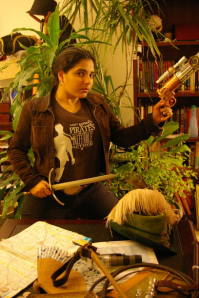 Day Al-Mohamed is author for the novel “Baba Ali and the Clockwork Djinn: A Steampunk Faerie Tale,” written with Danielle Ackley-McPhail. Day hosts the multi-author blog “Unleaded: Fuel for Writers” and edited the anthology, “Trust & Treachery,” just released May 1st, 2014. In addition to speculative fiction, she also writes comics and film scripts.
Day Al-Mohamed is author for the novel “Baba Ali and the Clockwork Djinn: A Steampunk Faerie Tale,” written with Danielle Ackley-McPhail. Day hosts the multi-author blog “Unleaded: Fuel for Writers” and edited the anthology, “Trust & Treachery,” just released May 1st, 2014. In addition to speculative fiction, she also writes comics and film scripts.
Her recent publications are available in “Daily Science Fiction,” Crossed Genres anthology “Oomph – A Little Super Goes a Long Way,” Sword & Laser, and GrayHaven Comics’ anti-bullying issue “You Are Not Alone.” She is an active member of the Cat Vacuuming Society of Northern Virginia Writing Group, a member of Women in Film and Video, and a graduate of the VONA/Voices Writing Workshop. She can be found at @DayAlMohamed.
Earlier this year, Disability in Kidlit asked its contributors the following question:
Why is it that diversity in young adult, middle grade, and children’s literature is often represented as an either/or, without intersectionality? Characters can either be autistic or gay, for example, or a wheelchair user or Black, but rarely both. Why do you think we see so few characters who are marginalized in more than one way?
We thought Day Al-Mohamed’s response required its own post …
I love this question and thank you for asking it! I want to take a moment to begin with the idea of identity and advocacy and movements. So, political messaging aside, during President Barack Obama’s speech on his second inauguration he referenced several historic civil rights movements; he referenced Selma, he referenced Seneca Falls, and her referenced the Stonewall riots.
When the world talks about rights and identities, these discussions have been shaped by their history and, in general, when examining these rights movements, while parallels and comparisons have been made, they are still described as separate struggles. And the sad thing is, by the discourse taking that track, it inevitably erases those individuals who have more than one identity. Whether intentional or not, individuals find themselves relegated to one identity over another finding themselves never fully able to hold close all parts of themselves.
In an article from Britney Wilson, “Black, Female, and Disabled: The Disintegration and Continuation of Struggle” and her experience at a historically black college and university (HBCU) she said,
As I sometimes imagine many black women must have felt during the Civil Rights Movement and Black Liberation Struggles, I realized that my identity consisted of more parts than I had previously allowed myself to admit, and that I had my own issues to consider that were not being addressed. I was not necessarily black or a black woman first anymore because a lack of plans and accessibility problems forced me to acknowledge that while black and black female empowerment oozed from every corner and crevice of campus, I was still in the minority when it came to my disability. [emphasis added]
This seems to be a case where art imitates life, or to be more accurate, a case where art imitates the perception of life. People are perceived as being gay or autistic or black and usually one of those identities is the “defining” one. If we are already seeing the “real world” in this sort of compartmentalization, seeing it in fiction becomes a natural outgrowth of these assumptions. Assumptions that if you are, as an example, autistic and Black, the former “trumps” the latter and the story and/or characterizations will highlight that, ignoring completely how family, culture, society, and other environmental factors impact how that individual engages with others and the world around them.
And of course this comes full circle as the depiction in the media and in fiction of specific subpopulations affect public perceptions, which ultimately have a real impact on people’s lives every time their fate depends on how they are perceived by others.[1], [2]
Just as we strive for accuracy in depicting disability in “kidlit” and we engage with advocacy that supports the need for greater diversity (#WeNeedDiverseBooks) in fiction, it is just as critical to recognize that “diversity” doesn’t live in a vacuum, or necessarily exist on its own, like singles slices of American Cheese – individually wrapped. 🙂 We are the sum of our experiences and influences. We are more than a single defining factor.
And that isn’t easy. Everything we see in the world, even our own psychology, likes “neat and tidy boxes,” our politics and perceptions, and even fiction teaches us to categorize and simplify. So when it comes to writing we have to be willing to examine, with suspicion, our own character creation and world-building. We should always be able to “Walk all the way around a character.” That means working hard not to fall into the traps we have been taught. We lament two-dimensional characters in fiction. Embracing that characters, just like people can have multiple identities and even conflicting feelings about those identities, as well as how that impacts how the world responds to them is a part of good writing, not just diverse writing.
[1] Dong, Q., & Murrillo, A.P. (2007). The Impact of Television Viewing on Young Adults’ Stereotypes Towards Hispanic Americans. Human Communication, 10 (1), 33-44.
[2] Entman, R.M., & Gross, K.A. (2008). Race to Judgment: Stereotyping Media and Criminal Defendants. Law and Contemporary Problems, 71 (93), 94-133.
Andrea Shettle reviews FIVE FLAVORS OF DUMB
 Andrea Shettle, a program manager at the U.S. International Council on Disabilities (USICD), is passionate about disability rights both domestically and internationally. At USICD, she coordinates an internship program for students and recent graduates who aspire to careers in international development. She also assists with the national campaign for U.S. ratification of the international disability treaty, Convention on the Rights of Persons with Disabilities (CRPD). In her free time, she reads voraciously. She blogs (and reblogs from others) about disability rights, the CRPD, and disability representation in books and other media. She published a fantasy novel in 1990, Flute Song Magic, which is out of print. Find her on Twitter and LinkedIn.
Andrea Shettle, a program manager at the U.S. International Council on Disabilities (USICD), is passionate about disability rights both domestically and internationally. At USICD, she coordinates an internship program for students and recent graduates who aspire to careers in international development. She also assists with the national campaign for U.S. ratification of the international disability treaty, Convention on the Rights of Persons with Disabilities (CRPD). In her free time, she reads voraciously. She blogs (and reblogs from others) about disability rights, the CRPD, and disability representation in books and other media. She published a fantasy novel in 1990, Flute Song Magic, which is out of print. Find her on Twitter and LinkedIn.
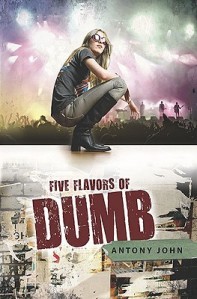 On the rare occasions that I stumble across a book featuring a disabled character while browsing, I gravitate to it. But I also feel afraid. Afraid to invest my hope in finding characters I like only to feel betrayed—again—to find that the character most like me is just there as a prop for another character’s personal growth. Afraid to feel betrayed—again—by an author only interested in using disability as a metaphor for “broken” or “twisted” spirits. As if our bodies belonged to them to use as metaphor. As if either our bodies or our spirits were automatically broken or twisted just because we are people with disabilities.
On the rare occasions that I stumble across a book featuring a disabled character while browsing, I gravitate to it. But I also feel afraid. Afraid to invest my hope in finding characters I like only to feel betrayed—again—to find that the character most like me is just there as a prop for another character’s personal growth. Afraid to feel betrayed—again—by an author only interested in using disability as a metaphor for “broken” or “twisted” spirits. As if our bodies belonged to them to use as metaphor. As if either our bodies or our spirits were automatically broken or twisted just because we are people with disabilities.
If you understand how badly disabled readers need to meet ourselves in a book, and if you also understand how often we’ve been betrayed, then perhaps you’ll understand the mingled excitement and trepidation with which I approached the task of reading Five Flavors of Dumb by Antony John. The protagonist, Piper Vaughan, is a young deaf woman finishing her last year of high school. She’s smart, academically successful, mainstreamed at a public high school, a wicked good chess player, and interested in attending Gallaudet University in part so she can finally be among other deaf signers like her. In these ways (apart from the chess) she is like me if you subtract a quarter century from my age.
In the story, Piper struggles to manage a new high school hard rock band called “Dumb”. Struggles, not because she is deaf, but because the band is comprised of members who do not always get along well. In the midst of all the drama involving “her” band, Piper also is figuring out how she wants to relate to her parents and her two siblings. The dynamics of how this plays out in the story is much influenced by Piper being deaf and her family hearing. But the dynamics are also much influenced by Piper being an ordinary adolescent figuring out who she wants to be as she emerges into adulthood.
If you’re just reading this review to know if there is a deaf/Deaf reader who is comfortable recommending this book as being largely free of stereotypes and other problematic representation, then here’s my short answer: Yes. Despite some flaws, it is clear the author did his research. I enjoyed this book and recommend it.
That’s the short answer. If you want analysis, this is where I get into that.
Let’s start with technical accuracy in portraying deafness. When dealing with things other than music, Antony John is pretty consistent in how he portrays Piper’s ability—and lack of ability—to hear the sounds around her. This is what makes it frustrating that he robs her of all ability to appreciate the music (or, as is often the case for this group of novice musicians, the chaotic noise) that the band, “Dumb”, produces.
Piper can hear well enough that her hearing aids significantly boost her ability to lip read others, at least in quiet situations where there aren’t other sounds to compete for attention. There is even one scene where she is able to catch a few words that another character speaks directly into her hearing aid even though she cannot see her face. Piper hears better than I do—just like plenty of real-life moderately deaf or hard of hearing people. Although I hear some loud, low pitched sounds and some limited speech, there’s nothing “moderate” about my hearing loss.
All this being the case, when Piper is standing close enough, she should be able to hear the sound of Josh singing even if she still misses what the words are. She should be able to hear Finn demonstrating a chord on his guitar even if she cannot reliably distinguish one chord from another or whether each chord sounds the way it should. And she also should be able to hear the band well enough to decide if she likes their music or not. In my case, I do hear music well enough—if well amplified—to know what I like and don’t like. And Dumb is never stingy with their amplification. Piper, who hears more than me, should be able to hear it also.
I think Antony John may have meant to amuse his hearing readers with the apparent “irony” of a deaf girl managing a band she cannot hear. Unfortunately he is apparently so enamored by this concept that he has allowed it to override the overall accuracy he otherwise achieved so well. If I had the power to direct a re-write, I would encourage him to consider either making her ability to hear and enjoy music more consistent for someone with a “moderately severe” hearing loss, or else making her more profoundly deaf (though the latter would mean making her less of a champion lip reader). I also would encourage him to consider the fact that there are many deaf people who love music even if they cannot hear it at all. They love the sensation of vibrations from a strong beat thrumming through their bodies, which can work well for hard rock and other loud, rhythmic music. And Anthony John does, in fact, sometimes describe Piper picking up the vibrations of the music in her body. So why should Piper be so alienated from the music that her band produces?
Despite this and some other minor issues, Antony John’s depiction of what it can be like to be deaf is still mostly on target. There are many little things he gets right, like Piper needing to remove her hearing aids before a hair stylist starts to wash her hair, or the fact that it’s easier to lip read people when they’re directly across the table from you than it is if they were next to you.
Although the author does fall for the tiresome trope of the champion deaf lip reader, Piper’s lip reading abilities are nevertheless largely consistent with her level of hearing loss. I also count in his favor that Antony John manage to show that lip reading isn’t an easy task even for a champion like Piper. She misses a homework assignment when the teacher’s announcement competes with the sounds of other students preparing to leave class. She has trouble understanding speech in the poor acoustic environment of the girl’s bathroom. It comes clearly that even a stellar lip reader is still working their butt off to make it work. It is clear why Piper prefers to use sign language when the opportunity is available.
Other things I like: Antony John avoids the trope of a single disabled character alienated from the disability community. Although she is apparently the only deaf student at her school, Piper does have a deaf friend who, like her, feels most comfortable signing. Granted, this is a friend who has moved away, which means Piper can only chat with her via computer. But it’s nice to see validation of the fact that many people with disabilities, particularly signing culturally Deaf people, have connections to others who share their disability and highly value these connections.
Antony John’s depiction of how hearing people react to Piper’s deafness is also true to life. Some, like Ed, seem comfortable with whom she is and adapt easily to her communication needs. A few other characters are obnoxious jerks who patronize Piper and underestimate her capabilities. And many characters are trying to do the right thing—at least sometimes—but are still somewhat clueless. This mix of reactions can be tricky to get right in fiction. I’ve seen other efforts that either have their disabled characters living in an unrealistically inclusive utopia, or else there might be one scene with clumsily blatant prejudice that does little to give a sense for the pervasiveness of micro-aggressions toward deaf people in daily life. Antony John steers the balance between these extremes well.
I also like the balance Antony John strikes between showing both Piper’s limitations as a deaf manager of a rock band and the strengths she is able to use to evade these limitations. She cannot, for example, realize without being told that the band only knows how to play songs that use a specific sequence of three chords. But she recruits her brother, Finn, and her friend, Ed, to help identify these and other weaknesses she cannot assess on her own. Meanwhile, Piper discovers a knack for marketing the band and negotiating deals. She also is able to “read” the dysfunctional relationships among the band members through sharp-eyed observation of facial expressions and body language, even in contexts where she cannot understand everything they say. She sometimes stumbles in managing these relationships—as you would expect from a young, inexperienced adult. But she learns from her mistakes.
Here, let’s shift gears to look at other kinds of diversity. The cast of Five Flavors is almost exclusively white, cis, and straight with the story set in a “predominantly white, middle-class suburb of Seattle”. There is only one important character, described as having dark skin, whose mother is African American. There is one other major character, Ed, whose last name is Chen. Otherwise, there is little racial or ethnic diversity, even among minor characters. It seems we are meant to read characters as white unless told otherwise.
Also, apart from Piper’s family temporary money issues, most characters seem to be either middle class or wealthy. Poverty is only addressed when the characters visit the old homes of rock stars. Antony John’s language often becomes lurid in passages that talk about poverty. I usually found myself feeling uncomfortable while reading these passages. They made me wonder if the way he writes about poverty is what some poor people have meant when describing the sensation of having their stories presented to the world as a form of “poverty porn.” Meaning, packaged to elicit emotional responses from people who haven’t experienced poverty without consideration for how poor people feel about their own experiences or about the presentation of their stories.
I think Antony John means for his descriptions of the former poverty of rock stars to elevate the importance of rock music for readers. But if so, these don’t have that effect for me. There were other scenes, in which characters talk about the personal meaning of certain pieces of music to them or in which characters react to the music they are listening to, that I felt were much more effective.
Despite my criticisms, I enjoyed getting to know Piper through this book and watching her grow as a problem solver, as a rock band manager, as a sister and daughter and friend. Although this book was weak in other areas of diversity, I feel that Antony John did a solid job of handling a deaf protagonist and hope he will consider writing more novels with disabled characters in the future—perhaps including a sequel to Five Flavors of Dumb.
Elise Phalen reviews 100 SIDEWAYS MILES
 Elise Phalen just graduated from Boston University with a degree in English Literature. She was diagnosed with epilepsy at 11, and is more than happy to answer your questions about it. Originally from Arizona, she has travelled the world, studying and living in Hermosillo, Mexico and Grenoble, France as well as interning at the 2013 Sydney Writers’ Festival in Australia. Elise is now back in the Boston area and divides her time between making coffee at Starbucks, working at the public library, and fretting about the future.
Elise Phalen just graduated from Boston University with a degree in English Literature. She was diagnosed with epilepsy at 11, and is more than happy to answer your questions about it. Originally from Arizona, she has travelled the world, studying and living in Hermosillo, Mexico and Grenoble, France as well as interning at the 2013 Sydney Writers’ Festival in Australia. Elise is now back in the Boston area and divides her time between making coffee at Starbucks, working at the public library, and fretting about the future.
 The first time I ever saw a character with epilepsy in literature, she eventually turned evil, cut off someone’s head in an ancient magic ritual, and then died in a burning castle.
The first time I ever saw a character with epilepsy in literature, she eventually turned evil, cut off someone’s head in an ancient magic ritual, and then died in a burning castle.
I was diagnosed with epilepsy at eleven and have had grand mal seizures on and off over the past 11 years. Looking back on that first reading, I am troubled that she met such an unfortunate end. But at the time I was ecstatic. It was life changing. My experiences existed in the fictional world. I was worth thinking about and my problems were worth writing about. The next time I saw a character with epilepsy in young adult literature, it was the narrator of 100 Sideways Miles, which I read almost seven years later.
In between these two readings, I mostly saw seizures on TV shows where the first aid was always wrong (I’m looking at you, Teen Wolf and Orphan Black). There are also the handfuls of upsetting moments when a character would dance badly and the other characters would laugh and compare their lack of rhythm to having a seizure. I would cringe as it hit me viscerally, wishing that I could scratch the words off the page and out of my memory.
Andrew Smith’s 100 Sideways Miles is essentially a bildungsroman, a coming of age story, about a boy, Finn, who goes on a road trip and comes to understand that he is still “too young and too stupid” and that the journey of coming of age is never really complete. Finn’s journey is also one towards coming to terms with his body and his autonomy, as connected to his epilepsy.
Epilepsy is a very complicated condition that no one experiences in exactly the same way, so Smith gets some leeway in how he portrays Finn’s seizures. But it was respectful and well researched in a way that I had never seen before. Smith did not ignore the importance of first aid or the realities people with epilepsy face on a regular basis. Finn experiences non-convulsive partial seizures and he faces them as something scary but somehow beautiful:
I am just standing there, and first I smell something sweet – like flowers or maple syrup. Then I realize that I don’t know the names for anything I am looking at…Sounds, colors, textures, all mash together in an enormous symphonic assault on my senses as I shrink down, smaller and smaller. I am not hot, cold, dizzy, or uncomfortable—because all of those things are words, which by that point the seizure have all floated away…It is all so beautiful.
Finn’s “atoms drift apart” and he is at the whim of the new world his seizure has created. For me, who has seizures primarily while I sleep, this haunted me in how much it resembled a reversed version of how I regain consciousness.
Smith does a good job for the most part of balancing a respectful portrayal of a complicated condition and accurately portraying the realities that accompany it. Smith is respectful, but Finn is angry. His anger manifests as outbursts following his episodes, and is generally accompanied by the panging guilt of lashing out at the people who care about you over something that neither of you can control.
In the plot, Finn’s seizures serve as a physical manifestation of his fear that he is stuck in the book his father wrote which contains a character clearly based on him. He feels out of control of his life and his destiny and attempts to reconcile his lack of bodily autonomy by taking control of the way he perceives the world, such as measuring in minutes instead of miles. Connecting disability to metaphor is difficult terrain to tread, but Smith does his best. Finn’s epilepsy is portrayed in its own right as an important part of his character and I felt it came across as a piece of what makes him who he is rather than simply a plot device.
The question of fate and autonomy is a prominent theme of 100 Sideways Miles. These issues are a huge part of my daily life: “Do I just have a headache or did I have a seizure in my sleep last night?” and waiting a full day after a seizure for my full motor capacity to return. It was nice to see that Smith didn’t shy away from the things that are real and scary about epilepsy and how it dictates your relationship with your body.
Treating a disability with thoughtfulness and respect goes beyond the plot and the metaphorical implications. It’s also the little things that matter and make it feel real, especially to those of us who actually live with that disability. Smith does not ignore that the frequency of Finn’s seizures have precluded him from learning how to drive. He portrays the desire to avoid the subject with strangers alongside the need for people to know how to deal with it in case he has an episode around them. I enjoyed the way that Finn dealt with these issues with equal parts awkwardness and bravery.
The book’s only truly distasteful moment for me came in the scene when his love interest Julia found him on his front porch after a particularly bad episode and later made a joke about possibly having taken a picture of his naked, unconscious body. With trends of this sort of things actually happening via social media lately, it was a vicious joke that I wish had not been included.
Beyond that disturbing scene, Smith left some key things out of his portrayal of the epilepsy experience. The most glaring thing missing was any mention of long-term medical treatment. Finn has no regular neurologist and doesn’t take any medication. I kept waiting for him to take his medicine or complain about the tedium of medical treatment, but it never came. My other disappointment was not Smith’s fault, but the choice on the part of his publisher not to include Finn’s epilepsy in the blurb on the back cover. How will my fellow epilepsy pals know that Finn is there if no one is telling them? This oversight reeks of ableism and shame when they should be proud of their epileptic boy and his grand adventure.
All in all, 100 Sideways Miles is not a perfect portrayal of what it means to have epilepsy. But it is respectful and spoke to me on unexpected levels. The story itself is a ton of fun and I enjoyed Finn and all his quirks. 100 Sideways Miles did its best and opened up doors for people to see epilepsy in fiction and to continue to think and write about it meaningfully. And hey, at least no one turned evil and died in a magical burning castle.
Emma Crees, Courtney Gilfillian, and s.e. smith review SAY WHAT YOU WILL
 Emma Crees is 32 and lives in Oxfordshire, UK. A life long wheelchair user she’s passionate about all things disability and can often be found online ranting about this. If she’s not ranting about disability she’s probably talking about books or writing. All of this and more is on her blog, A Writer In A Wheelchair, or on her twitter account @FunkyFairy22. When Emma isn’t online she can often be found knitting, sailing or volunteering.
Emma Crees is 32 and lives in Oxfordshire, UK. A life long wheelchair user she’s passionate about all things disability and can often be found online ranting about this. If she’s not ranting about disability she’s probably talking about books or writing. All of this and more is on her blog, A Writer In A Wheelchair, or on her twitter account @FunkyFairy22. When Emma isn’t online she can often be found knitting, sailing or volunteering.
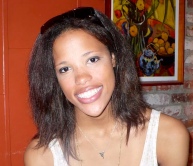 Courtney Gilfillian lives, writes, and works in New York City. She is constantly on the hunt for a good cocktail, the best pancakes in the city, and most of all a good book. Find her on Twitter at @whitegirlbkcvrs and at her blog about diversity in YA lit.
Courtney Gilfillian lives, writes, and works in New York City. She is constantly on the hunt for a good cocktail, the best pancakes in the city, and most of all a good book. Find her on Twitter at @whitegirlbkcvrs and at her blog about diversity in YA lit.
 s.e. smith is a writer, agitator, and commentator based in Northern California, with a journalistic focus on social issues, particularly gender, prison reform, disability rights, environmental justice, queerness, class, and the intersections thereof, with a special interest in rural subjects. International publication credits include work for the Sydney Morning Herald, The Guardian, and AlterNet, among many other news outlets and magazines. smith’s writing on representations of disability in science fiction and fantasy was recently featured in The WisCon Chronicles, Volume 7. Assisted by cats Loki and Leila, smith lives in Fort Bragg, California. You can follow s.e. on Twitter, ou personal site, Goodreads, and lots of other exciting places online.
s.e. smith is a writer, agitator, and commentator based in Northern California, with a journalistic focus on social issues, particularly gender, prison reform, disability rights, environmental justice, queerness, class, and the intersections thereof, with a special interest in rural subjects. International publication credits include work for the Sydney Morning Herald, The Guardian, and AlterNet, among many other news outlets and magazines. smith’s writing on representations of disability in science fiction and fantasy was recently featured in The WisCon Chronicles, Volume 7. Assisted by cats Loki and Leila, smith lives in Fort Bragg, California. You can follow s.e. on Twitter, ou personal site, Goodreads, and lots of other exciting places online.
Today, we’re hosting a discussion of Say What You Will by Cammie McGovern (titled Amy and Matthew in the UK). Our participants were Emma Crees, Courtney Gilfillian, and s.e. smith, who discussed the portrayal of both main characters’ disabilities–cerebral palsy and OCD–as well as several other disability-related issues that came up in the book.
Please note–this discussion contains spoilers.
John Green’s The Fault in Our Stars meets Rainbow Rowell’s Eleanor & Park in this beautifully written, incredibly honest, and emotionally poignant novel. Cammie McGovern’s insightful young adult debut is a heartfelt and heartbreaking story about how we can all feel lost until we find someone who loves us because of our faults, not in spite of them.
Born with cerebral palsy, Amy can’t walk without a walker, talk without a voice box, or even fully control her facial expressions. Plagued by obsessive-compulsive disorder, Matthew is consumed with repeated thoughts, neurotic rituals, and crippling fear. Both in desperate need of someone to help them reach out to the world, Amy and Matthew are more alike than either ever realized.
When Amy decides to hire student aides to help her in her senior year at Coral Hills High School, these two teens are thrust into each other’s lives. As they begin to spend time with each other, what started as a blossoming friendship eventually grows into something neither expected.
